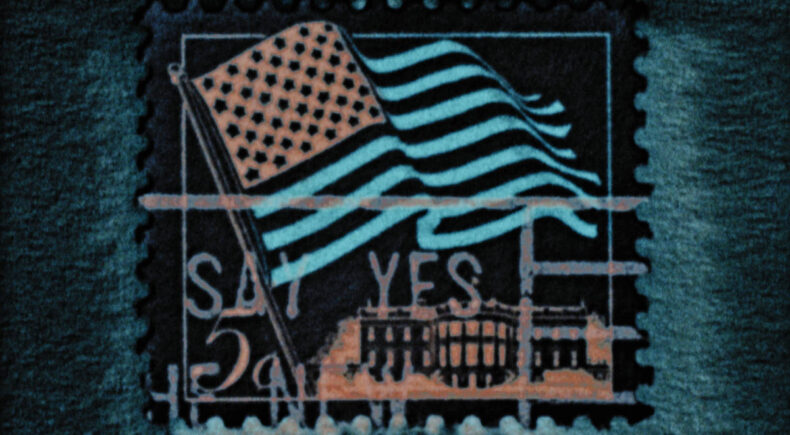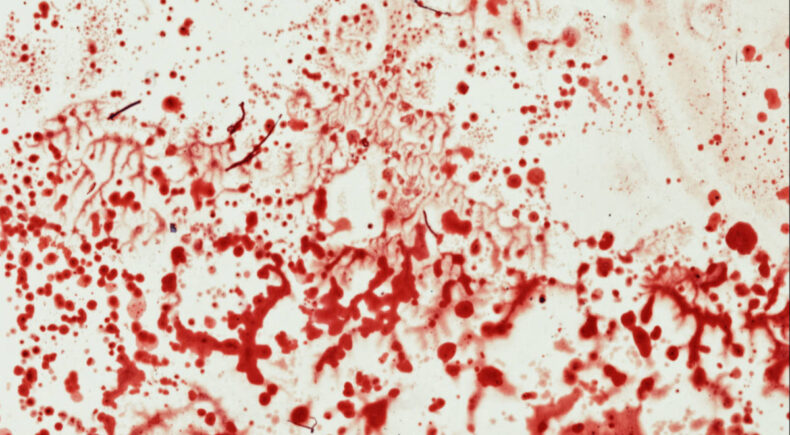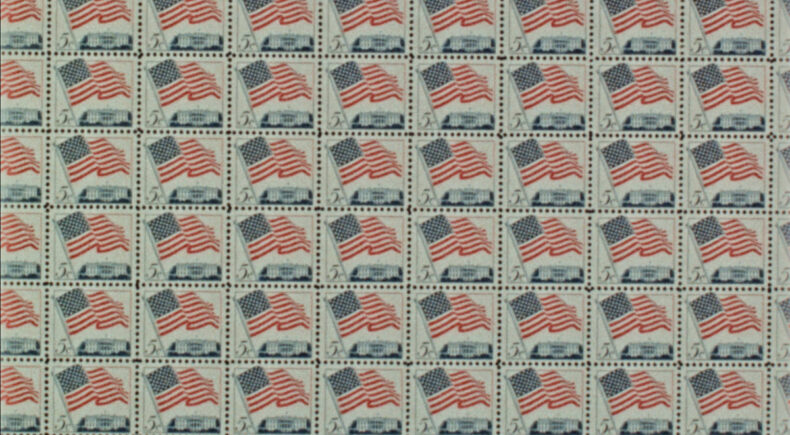5-cent American Flag
Director: Vito A. Rowlands
Belgium, United States, 2024, 7 min
Shooting Format:16mm
Festival Year:2025
Category:Experimental
Genres:Abstract cryptopolitical thriller, Experimental
Crew:Cinematographer, editor: Vito A. Rowlands. Music and Sound Design: Jordan Dykstra.
Email:vito@varowlands.com
Synopsis
5-cent American Flag takes a forensic approach to the conspiracy-fueled events of JFK’s assassination, creating an abstract cryptopolitical thriller that begs the question: which flags are we flying? More than 4,800 unique 5-cent American postage stamps from 1963 anxiously flutter across the screen, each bearing unique cancellation marks and slogans that become coded messages. The stamps were animated frame by frame over the distorted airwaves from a Gray Audograph recording of Dallas Police Department Presidential Motorcade communications on November 22, 1963, used by the FBI for acoustic gunshot analysis to determine the position of the shooter and the amount of gunshots. When words are absent on the soundtrack, custom-created rubber stamps applied to clear leader form black-inked cancellation marks that become enigmatic air waves, and red-inked U.S. flags are stamped and folded into the reel after the fatal gunshot(s) is heard on the tape, transforming into pareidolic bloodstain patterns that flood the screen.
About the director
Vito A. Rowlands (né Adriaensens, Antwerp, 1986) is a Belgian filmmaker and scholar. His feature script Elvis, We Like Your Music was a finalist at the 2021 Sundance Film Festival Development Track and his award-winning shorts have played around the world at venues such as the Ann Arbor Film Festival, the Alchemy Film and Moving Image Festival, Vienna Shorts, Aesthetica, the Cadence Video Poetry Festival, Raindance, the Brooklyn Film Festival, HollyShorts, Dresdner Schmalfilmtage, Mostra Internazionale del Cinema di Genova, and Nitehawk Shorts.
Vito has taught in Amsterdam, Brussels, and Copenhagen, as well as at Columbia University. He is currently an Assistant Professor of Experimental Film and Media at New York University's Tisch School of the Arts and a 16mm film instructor at Mono No Aware in Brooklyn. He is a co- author of Screening Statues: Sculpture and Cinema and the author of Velvet Curtains and Gilded Frames: The Art of Early European Cinema.
His first feature is the Metamorphoses-inspired 35mm anthology film Ovid, New York. He is currently in pre-production on his second feature: a silent, nineteenth-century set spiritualist thriller.
Filmmaker's note
In 1963, the American government removed the words “United States” from a postage stamp for the first time in history, arguing that a flag would suffice to identify it. The 5-cent American postage stamp featured a large flag flying over the White House and debuted in the year that John F. Kennedy was assassinated.
"5-cent American Flag" takes a forensic approach to the conspiracy-fueled events of JFK’s assassination, creating an abstract cryptopolitical thriller that begs the question: which flags are we flying? More than 4,800 unique 5-cent American postage stamps from 1963 anxiously flutter across the screen, each bearing unique cancellation marks and slogans that become coded messages. The stamps were animated frame by frame over the distorted airwaves from a Gray Audograph recording of Dallas Police Department Presidential Motorcade communications on November 22, 1963, used by the FBI for acoustic gunshot analysis to determine the position of the shooter and the amount of gunshots. When words are absent on the soundtrack, custom-created rubber stamps applied to clear leader form black-inked cancellation marks that become enigmatic air waves, and red-inked U.S. flags are stamped and folded into the reel after the fatal gunshot(s) is heard on the tape, transforming into pareidolic bloodstain patterns that flood the screen. Composer Jordan Dykstra carefully weaves percussive sound design, bass rhythms, and an audience into the elliptical Dallas Police tapes, using Lincoln car doors, engine sounds, and windshield wipers as his instruments.
Matching form to content and finding meaning in symbols and postmarks, "5-cent American Flag" takes a page out of the handbook of paranoid fiction and the conspiracy theories that dominate American politics more now than they might have ever done. It goes back to the origins of the splintering of the American psyche, an assassination that shocked a nation and undermined a sense of (political) reality. A flag is never just a flag, and no single flag can be seen to represent the United States as a whole today.





